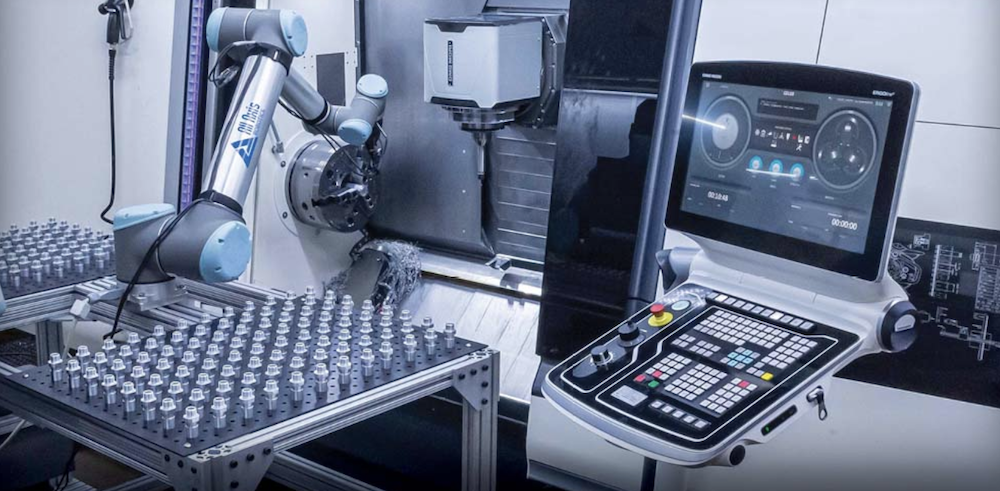
By Tyler Bouchard: 05/31/2024
New Cobot Report Identifies Top 5 Challenges Manufacturers Face Implementing CNC Robot Machine Tending
A recently released report by Verified Market Reports does an excellent job explaining the Top 5 challenges that manufacturers confront in adopting CNC Robotic Machine Tending automation.
Companies don’t always realize everything involved in cobot-enabling CNC machines, and why additional software digitalization technology like Flexxbotics will be required.
Top 5 Challenges
- Compatibility issues with legacy equipment & systems
- Software interoperability challenges
- Integrating cobots into existing workflows & production processes
- Ensuring safety of human workers in & around cobots
- Shortage of skilled workers with expertise in cobot programming and maintenance
As the report states:
“Ensuring the safety of human workers collaborating with cobots is paramount, as any malfunction or error could result in accidents or injuries. Manufacturers must adhere to stringent safety standards and regulations, such as ISO 10218 and ISO/TS 15066, and implement safety features such as force-limited control, collision detection, and emergency stop mechanisms to minimize risks. Additionally, integrating cobots into existing workflows and production processes can be complex and require significant time and resources. Compatibility issues with legacy equipment, software interoperability challenges, and the need for customized solutions can hinder seamless integration and adoption.”
Could not have said it better myself.
Overcoming these challenges in a standardized and scalable way is what the Flexxbotics solution does.
Let’s go through each point briefly:
1. Compatibility issues with legacy equipment & systems
Our unique breakthrough, the FlexxCORE™ technology which is at the center of the Flexxbotics solution, seamlessly connects and coordinates robots with existing capital equipment and IT systems.
Flexxbotics compatibility extends to over a 1000 different makes & models of CNCs, as well as, other factory machinery such as inspection equipment, deburring machinery, laser markers and many others.
2. Software interoperability challenges
Robots come with basic operating software that enables programmatic operation for motion and the ability to execute movement sequences. The robot’s software, however, was never designed to enable interoperability with other machinery or the coordination of multiple different machines’ operations with its own movements, much less the orchestration of factory-wide fleets of robots+machines.
That’s why Flexxbotics exists. Flexxbotics patent-pending technology, FlexxCORE, enables standardized connectivity and interoperability between Robots, Machines and Inspection Equipment in the Smart Factory. (No one else has this tech today)
3. Integrating cobots into existing workflows & production processes
Flexxbotics solution is designed for production robotic control, communication, and orchestration of all types of automation machinery, equipment and IT systems.
Flexxbotics provides a powerful and standardized way to connect and coordinate your production robots to your existing machinery, factory business systems, and people so you can scale robotic automation across your factories worldwide.
If your plan is to put a single cobot on one CNC and frequent human interference, stops or quality issues don’t matter, then you probably don’t need Flexxbotics. However, if you intend to install two or more cobots/robots with machinery in your factory, you will quickly figure out that you have to have Flexxbotics.
4. Ensuring safety of human workers in & around cobots
Flexxbotics further enhances the safety capabilities of robotics in machine tending scenarios, particularly collaborative robots. We include safety scanner capabilities for enhanced motion detection enabling people to work even more safely side-by-side with the robots in smart factory environments.
Flexxbotics bi-directional communication between the robots and the machines is also a significant safety enhancing factor. Direct communication to each machine’s PLC controller provides multiple layers of safety redundancy to ensure the right actions are being taken or not taken.
Flexxbotics makes the robots ‘aware’ of each machine’s processing instructions including real-time status. For example, Flexxbotics ensures that each part is fixtured correctly and that the auto-door on the CNC is closed before initiating a cycle-start.
With custom third-party PLC integrations and I/O tie-ins, your shop floor personnel are exposed to robot/machine safety issues due to a lack of coordination meaning your company assumes unnecessary liability risk.
Flexxbotics delivers the highest safety levels possible in robotic machine tending. With Flexxbotics the robot is instructing the machines to perform operations taking into account human safety and assuring that the robot is not in an unsafe position before initiating an action.
Flexxbotics also offers safety validation to ISO 10218, ISO/TS 15066 and other compliance requirements as an option with our implementation services.
5. Shortage of skilled workers with expertise in cobot programming and maintenance
Flexxbotics understands how to augment your staff’s skill levels and works with your team to bring together the physical and digital worlds. Our experts provide a full range of professional services for the Flexxbotics solution to ensure successful deployment and optimized operation.
Whether rolling out the Flexxbotics solution across a multi-site smart factory environment or a single workcell, the Flexxbotics team provides comprehensive deployment options to fit any strategic robotic automation roadmap.
Flexxbotics offers turn-key deployment, as well as, retrofit installations and robotic automation rescues. We work with your team to ensure success and achieve measurable business results on an ongoing basis.
In summary, we’ve created the Flexxbotics solution and structured our related services specifically to address the issues identified in the report which are common to all manufacturers from the most sophisticated automation groups to companies working with collaborative robots for the first time.
If you’re interested in learning more about how Flexxbotics and our team work in mission critical conditions, check out this case study >> download case study
